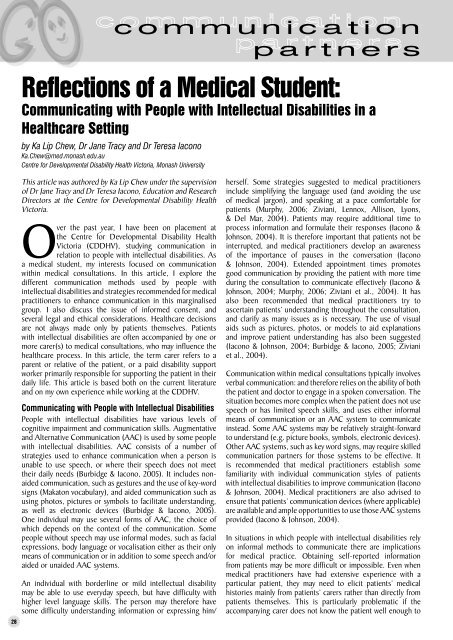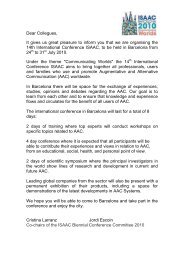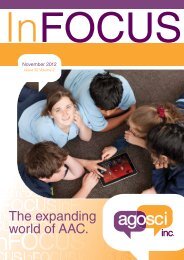May 2008 Edition - agosci
May 2008 Edition - agosci
May 2008 Edition - agosci
You also want an ePaper? Increase the reach of your titles
YUMPU automatically turns print PDFs into web optimized ePapers that Google loves.
ccommunicationo m m u n i c a t i o nppartnersa r t n e r sReflections of a Medical Student:Communicating with People with Intellectual Disabilities in aHealthcare Settingby Ka Lip Chew, Dr Jane Tracy and Dr Teresa IaconoKa.Chew@med.monash.edu.auCentre for Developmental Disability Health Victoria, Monash University28This article was authored by Ka Lip Chew under the supervisionof Dr Jane Tracy and Dr Teresa Iacono, Education and ResearchDirectors at the Centre for Developmental Disability HealthVictoria.Over the past year, I have been on placement atthe Centre for Developmental Disability HealthVictoria (CDDHV), studying communication inrelation to people with intellectual disabilities. Asa medical student, my interests focused on communicationwithin medical consultations. In this article, I explore thedifferent communication methods used by people withintellectual disabilities and strategies recommended for medicalpractitioners to enhance communication in this marginalisedgroup. I also discuss the issue of informed consent, andseveral legal and ethical considerations. Healthcare decisionsare not always made only by patients themselves. Patientswith intellectual disabilities are often accompanied by one ormore carer(s) to medical consultations, who may influence thehealthcare process. In this article, the term carer refers to aparent or relative of the patient, or a paid disability supportworker primarily responsible for supporting the patient in theirdaily life. This article is based both on the current literatureand on my own experience while working at the CDDHV.Communicating with People with Intellectual DisabilitiesPeople with intellectual disabilities have various levels ofcognitive impairment and communication skills. Augmentativeand Alternative Communication (AAC) is used by some peoplewith intellectual disabilities. AAC consists of a number ofstrategies used to enhance communication when a person isunable to use speech, or where their speech does not meettheir daily needs (Burbidge & Iacono, 2005). It includes nonaidedcommunication, such as gestures and the use of key-wordsigns (Makaton vocabulary), and aided communication such asusing photos, pictures or symbols to facilitate understanding,as well as electronic devices (Burbidge & Iacono, 2005).One individual may use several forms of AAC, the choice ofwhich depends on the context of the communication. Somepeople without speech may use informal modes, such as facialexpressions, body language or vocalisation either as their onlymeans of communication or in addition to some speech and/oraided or unaided AAC systems.An individual with borderline or mild intellectual disabilitymay be able to use everyday speech, but have diffi culty withhigher level language skills. The person may therefore havesome diffi culty understanding information or expressing him/herself. Some strategies suggested to medical practitionersinclude simplifying the language used (and avoiding the useof medical jargon), and speaking at a pace comfortable forpatients (Murphy, 2006; Ziviani, Lennox, Allison, Lyons,& Del Mar, 2004). Patients may require additional time toprocess information and formulate their responses (Iacono &Johnson, 2004). It is therefore important that patients not beinterrupted, and medical practitioners develop an awarenessof the importance of pauses in the conversation (Iacono& Johnson, 2004). Extended appointment times promotesgood communication by providing the patient with more timeduring the consultation to communicate effectively (Iacono &Johnson, 2004; Murphy, 2006; Ziviani et al., 2004). It hasalso been recommended that medical practitioners try toascertain patients’ understanding throughout the consultation,and clarify as many issues as is necessary. The use of visualaids such as pictures, photos, or models to aid explanationsand improve patient understanding has also been suggested(Iacono & Johnson, 2004; Burbidge & Iacono, 2005; Zivianiet al., 2004).Communication within medical consultations typically involvesverbal communication: and therefore relies on the ability of boththe patient and doctor to engage in a spoken conversation. Thesituation becomes more complex when the patient does not usespeech or has limited speech skills, and uses either informalmeans of communication or an AAC system to communicateinstead. Some AAC systems may be relatively straight-forwardto understand (e.g. picture books, symbols, electronic devices).Other AAC systems, such as key word signs, may require skilledcommunication partners for those systems to be effective. Itis recommended that medical practitioners establish somefamiliarity with individual communication styles of patientswith intellectual disabilities to improve communication (Iacono& Johnson, 2004). Medical practitioners are also advised toensure that patients’ communication devices (where applicable)are available and ample opportunities to use those AAC systemsprovided (Iacono & Johnson, 2004).In situations in which people with intellectual disabilities relyon informal methods to communicate there are implicationsfor medical practice. Obtaining self-reported informationfrom patients may be more diffi cult or impossible. Even whenmedical practitioners have had extensive experience with aparticular patient, they may need to elicit patients’ medicalhistories mainly from patients’ carers rather than directly frompatients themselves. This is particularly problematic if theaccompanying carer does not know the patient well enough to





